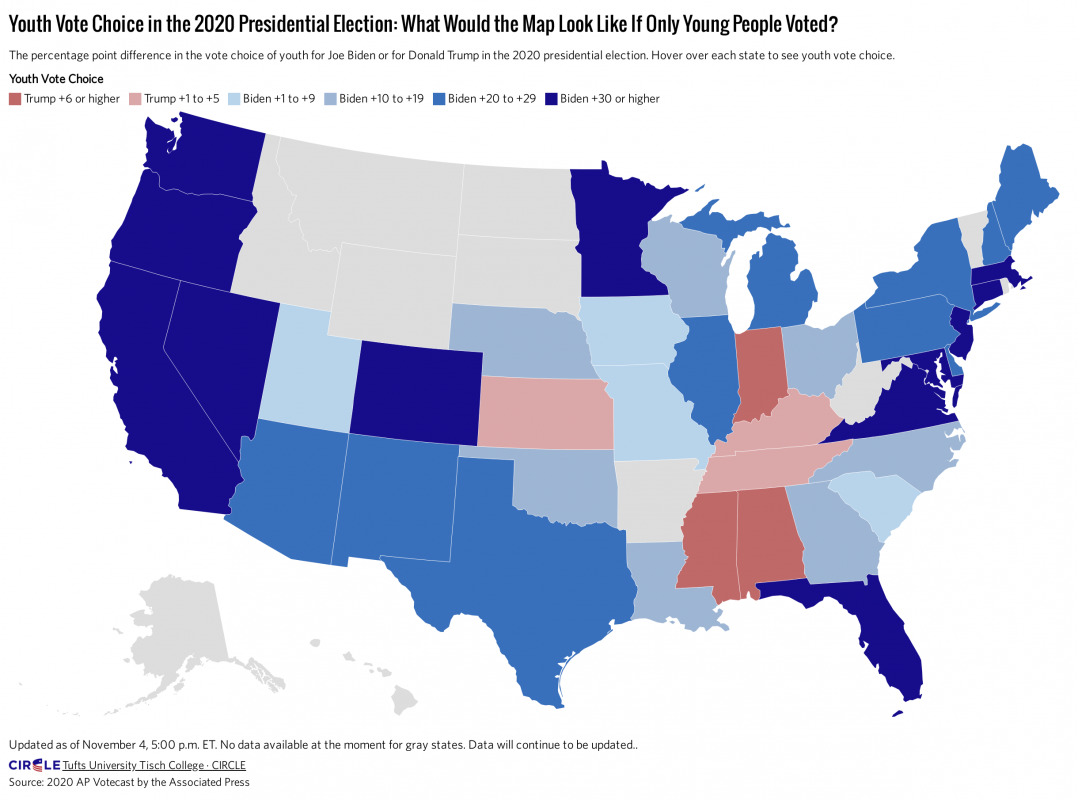As Americans were hanging on every update of the vote counting, Inside Higher Education posted a fascinating–and overall encouraging–graphic.

The embedded image shows the election results we would have gotten had we counted only the votes cast by those under 30. In a real sense, it also is a snapshot of each state’s “political future.” Overall, the map is comforting–results range from light to dark blue in large areas of the country, confirming my often-stated belief that the younger generation overall is more inclusive, more community-minded and “with it” than my own.
Voters under age 30 leaned heavily Democratic, favoring Joe Biden over President Donald Trump by a wide margin (61 versus 36 percent) in the recently-called presidential election, but there were key differences among young voters across gender, racial and state lines, according to an analysis of exit polling data from the Center for Information and Research on Civic Learning and Engagement (CIRCLE) at Tufts University in Massachusetts
That said, there are some disappointing elements to the analysis. For one thing, young white men supported Trump by a six-point margin (51 versus 45 percent).( I am happy to report that young white women favored former vice president Biden by 13 percentage points (55 to 42 percent)).
Even more disquieting for my family of Hoosiers, Indiana remained red amid the varying shades of blue. Young people in Indiana will evidently carry on the state’s tradition of minimal, largely ineffective government and widespread racial antagonism. As my son recently pointed out, higher-education levels are low in the state, and young Hoosiers who graduate from college leave Indiana at a high rate.
Other states show evidence of evolution, albeit with that same disquieting racial breakdown:
In Georgia and North Carolina, 90 percent or more of young Black voters chose Biden, while more than half of young white voters (54 percent in North Carolina and 63 percent in Georgia) favored Trump.
In Texas, Latinx voters supported Biden over Trump by a nearly 50-percentage-point margin (73 versus 25 percent), while a majority of young white voters preferred Trump (51 versus 45 percent for Biden).
My son pointed to the analysis as justification for his advice to his teenage children–“find a better place to live; don’t come back to Indiana; we’ll follow you.” That advice was more anecdotal evidence supporting Bill Bishop’s Big Sort assertion that Americans are voting with our feet, and “sorting” geographically into locations where our neighbors share our political convictions.
None of this bodes well for Indiana. The past couple of decades have seen small towns continue to empty out. Children born in those towns, and the rural areas that surround them, have migrated either to metropolitan areas within the state, or left Indiana entirely. The super-majority of Republicans dominating our state’s legislature has waged war on public education, creating a voucher program that sends already scarce education dollars to (almost always religious) private schools, several of which teach creationism in lieu of science.
Indiana’s legislature has also defunded higher education, resulting in Indiana’s finest colleges admitting ever more out-of-state students who tend to leave after graduation.
The low levels of education and the relatively low levels of diversity around the state contribute to a situation that’s exacerbated by the “winner take all” law that is the worst aspect of the Electoral College. Even if 49.5% of Hoosiers somehow voted for a Democrat, the state’s Eleven Electoral Votes would be awarded to a Republican who received 50.5%, a situation that encourages the legislature to ignore dissenting voices. That’s not a situation likely to bring talented people to Indiana, or to keep those we manage to raise.
People move to livable communities. Strike one against Indiana’s creation of such communities is our neglect of infrastructure. Strike two is inadequate funding of education. Strike three, as displayed on the embedded map, is the fact that Indiana voters — today and evidently into the future — can be counted on to support know-nothings and White Supremacists up and down the ballot.
Indiana–the Mississippi of the North….
Comments